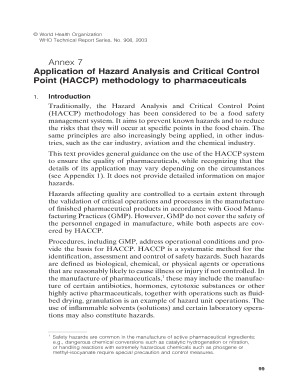
Get Who Technical Report Series No 908 2003 Annex 7 Application Of Hazard Analysis And Critical Control
How it works
-
Open form follow the instructions
-
Easily sign the form with your finger
-
Send filled & signed form or save
How to use or fill out the Who Technical Report Series No 908 2003 Annex 7 Application Of Hazard Analysis And Critical Control online
The Who Technical Report Series No 908 2003 Annex 7 provides guidance on the application of Hazard Analysis and Critical Control Point (HACCP) methodology to pharmaceuticals. This guide aims to assist users in navigating the online form effectively, ensuring that they comprehend each section and can complete it accurately.
Follow the steps to fill out the form accurately and efficiently.
- Click ‘Get Form’ button to access the document and begin filling it out in the online editor.
- Begin with the introductory section where you will find an overview of HACCP methodology. Familiarize yourself with the purpose and principles of HACCP as this will provide context for your application.
- Fill in the details regarding your pharmaceutical product, including its intended use and target population. This information is vital for assessing potential hazards linked to the product.
- Describe the production process thoroughly. It’s essential to provide a detailed flow diagram as this serves as a roadmap for identifying critical control points in the manufacturing process.
- Conduct a hazard analysis by identifying potential hazards associated with each step in the flow diagram. Ensure to distinguish safety hazards from quality hazards.
- Determine the critical control points (CCPs) by applying a decision-tree approach. This step is critical in ensuring that potential hazards are effectively controlled.
- Establish critical limits for each CCP. Document the criteria needed to ensure that each critical control point remains under control.
- Create a monitoring system for each CCP. Clearly outline how monitoring will be conducted and recorded to ensure compliance with set critical limits.
- Detail the corrective actions to be taken if monitoring indicates a loss of control. Ensure these procedures are robust and actionable.
- Establish verification procedures to confirm the effectiveness of the HACCP system. Include how and when these verifications will be conducted.
- Document all procedures meticulously. Accurate records will support the implementation and compliance with the HACCP plan.
- Review your form for completeness. Once satisfied, you can save your changes, download, print, or share the completed form to ensure it is submitted appropriately.
Start completing the Who Technical Report Series No 908 2003 Annex 7 form online now to ensure you prepare a comprehensive HACCP application.
The seventh principle of HACCP emphasizes the importance of maintaining detailed record-keeping and documentation to support food safety efforts. This principle requires that businesses establish procedures for recording data related to critical control points and monitoring activities. Such documentation not only streams lines accountability but also complies with the requirements stated in the Who Technical Report Series No 908 2003 Annex 7 Application of Hazard Analysis and Critical Control. By following this principle, companies can ensure they maintain compliance and demonstrate their commitment to safety.
Industry-leading security and compliance
-
In businnes since 199725+ years providing professional legal documents.
-
Accredited businessGuarantees that a business meets BBB accreditation standards in the US and Canada.
-
Secured by BraintreeValidated Level 1 PCI DSS compliant payment gateway that accepts most major credit and debit card brands from across the globe.


